Search Results for 'mysteries'
Did you find what you wanted ?
Tue 15 Oct 2013
Posted by Steve under
Reviews[8] Comments
PATRICIA HARWIN – Arson and Old Lace. Pocket, paperback original; 1st printing, Feb 2004.
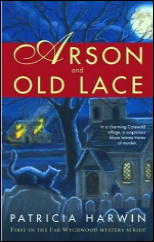
Oh, why not. I’m going to quote all of the first two paragraphs. Telling her own story is Catherine Penny:
I pulled the car in close to the hedgerow and turned the key, and that amazing silence came down. It was the silence I had been waiting for more than a year, since my husband had left me, since I’d decided my only hope of peace lay in the ancient rhythms of an English village.
I used to wake in our apartment on West Eighty-third and listen for that silence through Manhattan’s background hum. Keeping by long habit to my side of the bed, I would see behind closed eyelids the narrow country road and the old cottages with roses in bloom on their walls, as they had been when Quin and I had first come to Far Wychwood.
I submit to you that there are few mystery novels that summarize their mood, their setting, and one of the characters as quickly as this. Catherine is in her sixties, a recent grandmother — her daughter and her husband live not too far away, near Oxford — and as you’ve gathered, newly divorced.
There are challenges for everyone in this world, but packing up and moving across the ocean by yourself, leaving your previous life behind, is not one that most people would voluntarily undertake. Across the road, Catherine has a neighbor, an ill-tempered old man who loves alone, nearly incapable of caring for himself, and considered dishonest by the surrounding townspeople. And thereby lies the tale.
When old George’s house burns down, it is Catherine who hears his dying words. And when a body is found in the churchyard next to a huge ornamental cross, who is nearby? Catherine again.
This is the first of a series, and for the most part, it starts off on the right foot, especially when it focuses on Catherine’s life: her struggles with her daughter, who has her own views of raising children; her attempts, largely successful, to make friends with her new neighbors; her bouts of nostalgia with a marriage that was so happy and then so suddenly wasn’t.
Not so successful is the mystery itself, as elements of the plot so obvious to the many-times-over detective fiction reader go flitting over the heads of the people in Catherine’s close circle of new friends, which includes the local constabulary, Detective Sergeant John Bennett. (Not a love interest. He’s happily married.)
That it slips Catherine’s mind to tell Sgt. Bennett everything she knows causes considerable problems as well. Red herrings and false trails abound, but if you stay with the obvious, you’ll be headed in the right direction. You won’t know all — the pieces don’t go together that easily — but you’ll be idling your thumbs for a bit while the story catches up.
And Catherine Penny, prone as she is to rash and impulsive behavior, is a bit of fascination in herself. It’s too bad that we’ll have to wait until Fall of 2005 for a return visit, scheduled to be told in Slaying Is Such Sweet Sorrow.
[UPDATE] 10-15-13. Unfortunately, as it turns out, there were only the two books in the series. 2005 was about the time (as I recall) that Pocket cut way back on “genre” fiction: mysteries, science fiction and westerns — one large implosion and they were all gone — and that may have been one of the reasons that Catherine Penny had only the two cases on record.
Mon 7 Oct 2013
A 1001 MIDNIGHTS Review
by Bill Pronzini
JOHN HOLBROOK VANCE – The Fox Valley Murders. Bobbs-Merrill, hardcover, 1966. Ace, paperback, no date [1972].
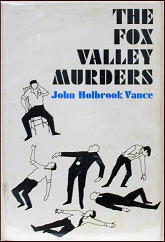
John Holbrook Vance is one of a handful of writers who have won major awards in two different genres. In the science-fiction field, where he writes as Jack Vance, received a Hugo for his 1963 novel The Dragon Masters — and in the mystery field, he received a Best First Novel Edgar for his 1960 tale of intrigue in Tangier, The Man in the Cage.
Vance has published a dozen mysteries, most of the formal variety. The two best feature Sheriff Joe Bain of the fictional central California county of San Rodrigo; The Fox Valley Murders is the first of these.
A smallish agricultural county south of San Jose, San Rodrigo is loosely modeled on the one in which Vance spent his childhood. He portrays it with a great deal of feeling and clarity, utilizing a variety of towns and rural settings much as Dennis Lynds, writing as John Crowe, would do a few years later in his “Buena Costa County” series.
People and places are so strikingly depicted, and county history, social problems, and politics so well integrated into the narrative, that San Rodrigo inhabitants seem utterly real.
In The Fox Valley Murders, Bain — a wild youth who has settled down to become a very good lawman — has been appointed acting sheriff after the recent death of old Ernest Cucchinello, the incumbent for many years and a man not above a little corruption. The county elections are not far off.
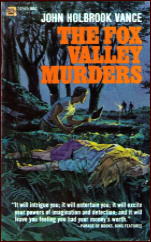
Bain wants the sheriff’s job permanently, campaigns hard for it, but is facing stiff competition from a well-backed progress-and-reform group. He is also facing a volatile situation centered around Ansley Wyett, a native of the town of Marblestone, who was convicted sixteen years before — despite his protestations of innocence — of the brutal rape/murder of a thirteen-year-old girl. Now out of San Quentin on parole and back home, Wyett has written the same letter to eachof the five men whose testimony sent him to prison, asking: “How do you plan to make this up to me?”
It isn’t long before the five recipients begin to die one by one in apparent accidents. Is Ausley responsible? And if not, then who is? And why? And, just as important, how? How do you make a man die of a heart attack in front of a witness (Bain himself)? How do you cause a man who has been picking mushrooms all his life to eat a poisonous toadstool? How do yon make someone fall off a ladder and break his neck in full view of his wife, with no one else around?
Bain is hard-pressed to find the answers before local citizens decide to take the law into their own hands and/or the election sweeps him right out of office.
Brimming with suspense, evocatively written, ingeniously constructed (with a number of dovetailing subplots and plenty of clues for the armchair detective), this is a first-rate novel that “fills the bill for real entertainment in the true sense of the word” (King Features Syndicate).
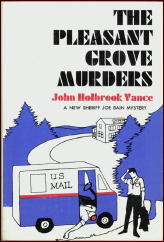
Almost as good is Joe Bain’s second case, The Pleasant Grove Murders (1967), in which the likable and very human sheriff once again faces political problems and a baffling multiple homicide (three brutal hammer murders).
Notable among Vance’s other mysteries are a pair under pseudonyms, both published in 1957 — Isle of Peril, as by Alan Wade, and Take My Face, as by Peter Held; The Deadly Isles (1969), a tale of murder in Tahiti and the Marquesas; and Bad Ronald (1973), a psychological thriller.
———
Reprinted with permission from 1001 Midnights, edited by Bill Pronzini & Marcia Muller and published by The Battered Silicon Dispatch Box, 2007. Copyright © 1986, 2007 by the Pronzini-Muller Family Trust.
R.I.P. JOHN HOLBROOK VANCE (1916-2013). Jack Vance died last May at the grand old age of 96. He was far better known for his works of fantasy and science fiction. Personally I have been reading his novels and short stories since I was in my teens, and I hope to for many more years. It is his wonderful, often playful use of words and the English language that I will remember the most.
Wed 2 Oct 2013
FIRST YOU READ, THEN YOU WRITE
by Francis M. Nevins
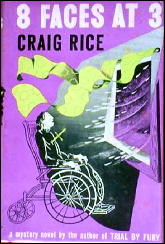
The latest golden oldie I decided to revisit in my golden years is 8 FACES AT 3 (Simon & Schuster, 1939), which I first read in the summer of 1964, just before I entered law school. Craig Rice (1908-1957), one of the most popular female mystery writers of her generation, entered the genre with this novel, along with alcoholic criminal defense lawyer John J. Malone, drink-sodden talent agent Jake Justus, and ever-inebriated heiress Helene Brand, who would become Mrs. Jake in future outings.
Amid copious shots of booze the trio probe the stabbing death of vicious old Chicago dowager Alexandria Inglehart, whose murderer also made all the beds in the Inglehart mansion and (dare I say it?) took the time to stop all the clocks in the house at 3:00. The plot is marred by logical holes and legal howlers — sorry, Ms. Rice, but no court would enforce a will provision nullifying an outright bequest if the recipient marries after the testator’s death — and the solution is surprising but only mildly fair and a bit hard to swallow.
What I found most striking about this novel is the interweaving of some all but noirish sequences with scads of drunken escapades. Rice seems to think that hoisting a few while driving along Chicago streets that have turned to sheets of ice is the height of hilarity, although when held up against the later exploits of Malone and his buddies this one is a model of rationality and sobriety. The critics who have likened Rice’s world to Hollywood’s screwball comedies of the Thirties knew what they were talking about.
How do I know precisely when 8 FACES first came into my ken? Because, rummaging in my file cabinets between sessions with Rice’s madcap protagonists, I discovered an old notebook containing comments on the mysteries I had read back in the Sixties and Seventies. Dozens of these clumsily written paragraphs became the rough sketches for material that wound up in various essays of mine, like the ones on Cleve F. Adams, William Ard and Milton Propper; many others have been seen by no eyes but my own.
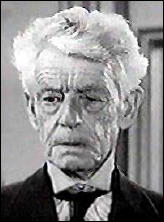
Among the subjects of the latter is Clyde B. Clason (1903-1987), who wrote ten well-regarded classic puzzle novels in the 1930s and early Forties before giving up the genre permanently. Protagonist of all ten is Professor Theocritus Lucius Westborough, a little old man whose day job is teaching classical languages and literature but whose true forte is solving bizarre murders.
Anyone remember an actor named Cyril Delevanti? He was a dried-up old prune who, usually uncredited, played clones of himself in dozens of movies, including Chaplin’s Monsieur Verdoux and Limelight and John Huston’s Night of the Iguana, and a hundred or more episodes of TV series like Gunsmoke, Perry Mason, Have Gun Will Travel, Alfred Hitchcock Presents, Ben Casey and The Twilight Zone.
For me Delevanti is the living image of just about every little-old-man detective character, including Henry the Waiter in Isaac Asimov’s Black Widowers stories and, of course, Clason’s Professor Westborough. In my mind’s ear I can almost hear Delevanti murmuring “Dear me†as Westborough does times without number.
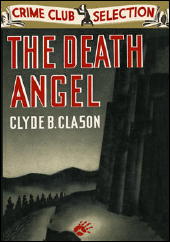
Of Clason’s ten novels I’ve only read three, the earliest being THE DEATH ANGEL (1936). On a visit to a friend’s estate in southern Wisconsin while local farmers are staging a violent milk strike, Westborough is deputized by the sheriff after his host first receives a threatening note signed “The Firefly†and then vanishes.
The professor investigates the series of attempted murders that follow and encounters two clever ways of setting up a perfect alibi and perhaps a bit too much information about archery, mushrooms and the theory of electricity. Clason‘s characters tend to evade, drawl, growl, grunt, explode, supply, venture, persist, ejaculate and flare, but most of his said substitutes aren’t too outrageous and his plot convolutions are spectacular.
The later Westborough novels tend to revolve around ancient or exotic settings. MURDER GONE MINOAN (1939) takes place on a private island off the California coast, owned by a Greek-American department-store tycoon with a phobia about the imminence of another Depression and a passion for the millennia-old Cretan civilization. When a priceless Minoan religious image disappears from the tycoon’s Knossos-like palace, Westborough is asked to investigate and encounters a mess of amorous intrigues and two murders apparently committed by a devotee of the ancient Cretan snake goddess.
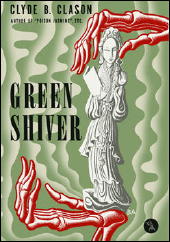
The parts of the story told in transcript and document form are neatly handled, but the mind boggles at the amount of physical action this frail 70-year-old academic takes part in, and the solution he comes up with is hopelessly unfair (except to readers who can tell whether a particular classical quotation comes from the Iliad or the Odyssey). The said substitutes, plus a small army of exclamation points, are piled on with a vengeance.
In GREEN SHIVER (1941), Clason’s tenth and last detective novel, the place and time are southern California in early 1940. As in MURDER GONE MINOAN, the first crime is the theft of an exotic religious image, this time a jade Taoist goddess which vanished from the Oriental palace of an oil widow during a public exhibition of her treasures to benefit Chinese war refugees.
Westborough, who is suddenly gifted with expert knowledge of ancient China as well as Greece and Rome, is offstage far more than in earlier Clasons but quickly gets involved in a bizarre double murder with occult overtones. The clumsy plot depends on an unplanned perfect alibi, but the Sino-Japanese war background is well evoked and Clason’s knowledge and love of Chinese philosophy and culture enliven every page.
Have I been a little unfair to Clason? According to a slew of experts — Robert Adey, Jon Breen, Bob Briney and Randy Cox, just to name a few from the early letters of the alphabet — by far the finest of his ten novels is THE MAN FROM TIBET (1938), which I’ve never read. If I ever come across a copy, I’ll be sure to write it up in this column.
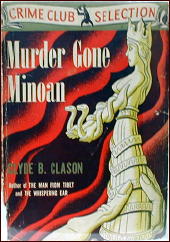
In Clason’s MURDER GONE MINOAN, Westborough satisfies himself that a man claiming to be a fellow classics professor is an impostor by quoting a verse apiece from the Iliad and the Odyssey and not being corrected when he attributes each verse to the wrong epic poem. Somehow this incident brought back memories of other mysteries where the detective character used his specialized knowledge in the same general way.
Perhaps the best known is found in “The Blue Cross,†the earliest exploit of G.K. Chesterton’s most famous character. At the climax Father Brown explains to the thief Flambeau, who is impersonating a priest, how from their dialogue he knew the other was a fake. “You attacked reason. It’s bad theology.â€
One of my favorite scenes of this sort — largely because it doesn’t require reader familiarity with specialized subjects like Greek poetry or Catholic theology — occurs in Rex Stout’s 1946 novelet “Before I Die.â€
Nero Wolfe is having dinner with a young man who claims to be a third-year law student. “I hope…that you are prepared to face the fact that very few people like lawyers,†Wolfe says. “I don’t. They are inveterate hedgers. They think everything has two sides, which is nonsense. They are insufferable word-stretchers. I had a lawyer draw up a tort for me once, a simple conveyance, and he made it eleven pages. Two would have done it. Have they taught you to draft torts?â€
“…Naturally, sir, that’s in the course,†the young man replies. “I try not to put in more words than necessary.†That, as Wolfe explains at the denouement, was the tipoff. “A tort is an act, not a document, as any law student would know. You can’t draft a tort any more than you can draft a burglary.†“Before I Die†is one of the clumsiest of all the shorter Wolfe exploits but that single moment keeps it green in my memory.
Editorial Notes: My review of Murder Gone Minoan can be found here. Curt Evans’ review of 8 Faces at 3 can be found here.
Tue 17 Sep 2013
THE BACKWARD REVIEWER
William F. Deeck
“DIPLOMAT” – Murder in the State Department. Jonathan Cape & Harrison Smith, hardcover, 1930.
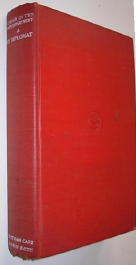
“Diplomat” dedicates this, his first mystery, to the “pacifists and bootleggers of the United States, without whom the author would have been at a loss for a motive for a murder in the State Department.” This gives you some idea of the tone of the book, and those who are neither pacifists nor bootleggers may read safely on with the pleasant anticipation that someone else’s ox will be gored.
A guard at the State Department finds Harrison “Handsome” Howard in his office, a steel filing spike transfixing a top-secret unsigned treaty, Howard’s hand, and Howard’s heart, in that order. Also in the office is a revolver with a silencer, unused.
(Who is it that makes silencers for revolvers? Does anyone outside the characters in mysteries purchase them? Why is there never dissatisfaction with their performance?)
Only one other person is working in the building — Howard’s rival for position and prestige. He, however, has an unimpeachable alibi. Dennis Tyler, Chief of the Bureau of Current Political Intelligence (Now there’s an oxymoron! Oops. Sorry.) has a low opinion of police investigators, so he takes charge.
Tyler talks like a mixture of Bertie Wooster and Reggie Fortune; his intellect, at least to this reader, is closer to Bertie’s than Reggie’s. Still, he does come up with the solution, which is for the most part plausible. Those who can accept an exchange like the following with good heart and maybe even appreciation should enjoy the novel:
“The chemical man turned over to the parson a cylinder of a secret new gas, the effect of which is to make people go to sleep….”
“Ether?” Nichols suggested.
“Either that or something like it,” Tyler admitted.
Amiable nonsense, for which I admit a weakness.
— From The MYSTERY FANcier, Vol. 12, No. 2, Spring 1990.
Bibliographic Notes: “Diplomat” was, according to Hubin, the pseudonym of John Franklin Carter, 1897-1967. According to Wikipedia, Carter was an American journalist, columnist, biographer and novelist. Dennis Tyler appeared in all of the novels Carter wrote under that name, as follows:
Murder in the State Department (n.) Cape & Smith 1930.
Murder in the Embassy (n.) Cape & Smith 1930.
Scandal in the Chancery (n.) Cape & Smith 1931.
The Corpse on the White House Lawn (n.) Covici Friede 1932.
Death in the Senate (n.) Covici Friede 1933.
Slow Death at Geneva (n.) Coward 1934.
The Brain Trust Murder (n.) Coward 1935.
Al Hubin reviewed this same title earlier on this blog; you may check it out here. In the course of the review and the update that followed, much more information about the author was supplied. (You may also enjoy Al’s opinion of the book, and compare it with Bill had to say.)
Thu 5 Sep 2013
CLYDE B. CLASON – Murder Gone Minoan. Rue Morgue Press, trade paperback, 2003. Original hardcover: Doubleday Crime Club, 1939. Pulp magazine reprint: Two Complete Detective Novels, Winter 1939-1940 (with The Cat Saw Murder, by D. B. Olsen). Hardcover reprint: Sun Dial Press, 1940.
Checking on www.abebooks.com just a few minutes ago, I found only one copy of the Crime Club edition for sale: Near Fine in a Near Fine jacket. Price: a mere $250.00. Further searching revealed a few other copies on other venues, one being a former library copy with no jacket. Price: a much more reasonable $35.00.
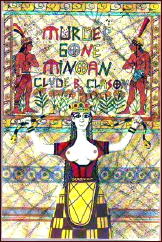
But if $14.95 is all you want to spend, this handsome trade paperback will do very nicely. This is but one of many classic mystery reprints coming from Tom & Enid Schantz of Rue Morgue Press, and they should be commended for a job well done, and for jobs yet to be done. (At the moment, the only other Clason title they’re published is The Man from Tibet, but perhaps others are on their way. Only sales will tell, I imagine.)
Only one thing is lacking, before I continue, and that is the original cover art, which as I recall was by Boris Artzybasheff. That gentleman no longer being available (or affordable) a fine piece of work by Rob Pudim was used in his stead. To my eye it’s a bit cluttered, but it Does Catch the Eye.
Clason’s series detective is an eminent Roman historian named Theocritus Lucius Westborough — Westborough for short — who also has earned a well-deserved reputation as a private investigator on the side. If this book is an example — which from my point of view it has to be, at least for the moment, since if I ever read an earlier book in the series, it was long ago and long forgotten — Westborough’s adventures are copiously filled with well-researched lore of ancient times, interspersed with mini-lectures on the same.
I’m jumping the gun here, but it’s Westborough’s knowledge of ancient history that helps crack a killer’s alibi — which is not quite fair to the reader not recently tutored in such matters — such as myself, I have to admit — but it’s a sizable step above nabbing a villain who reveals himself because he’s not aware that buildings do not have thirteenth floors, for example.
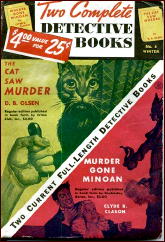
Just in passing: There is a deliberate misstatement on my part that is not quite correct in the last sentence of the previous paragraph, but if I were to speak more clearly, I would be revealing more of what Clason had up his sleeve than I should.
This, the seventh of ten cases Westborough is on record as having solved, takes place on an isolated island off the southern California shore, where first a valuable artifact is stolen — and Westborough called in — and then murder, when a missing butler is later found dead.
The owner of the island, a rich Greek businessman named Paphlagloss, is fascinated with the ancient Minoan culture, pre-historic Cretans whose civilization arose and fell even before the ancient Greeks, and his mansion is filled with valuable relics, artwork and jewels. Just the right place for skullduggery to be done, and with only a handful of suspects, one of whom is responsible for doing the dugging, it’s a perfect setting for a mystery.
Clason’s strength is in his characters and their dialogue. To my ears, the lengthy reports of letters and verbatim interviews of suspects are close to perfect. Other parts of the tale are excellent, while others, contrarily, are pure fuddle-muddle.
I like the following quote, for some reason, taken from pages 160-161. Paphlagloss’s daughter is having a private conversation with Westborough:

She shivered and drew the wrap closely to her slim body. “Why do things have to be in such a perfect devil of a mess?”
His mild eyes peered distressfully through his gold-rimmed spectacles. “The question, I should conjecture, has been propounded rather frequently during the four thousand years of recorded history. However, I am unable to recall a single instance where it was answered satisfactorily.”
“You are very wise!” she exclaimed.
He shrugged deprecatorily. “My wisdom is confined to a single fact. I have lived long enough to learn that most of my fellow creatures — and myself, as well — must of necessity be a little foolish.”
“What would you advise me to do?”
“I dare not advise you, my dear. The situation is too delicate. As delicate,” he added thoughtfully, “as the ripples of a Chinese nocturne.”
While it’s great to have this small gem of the Golden Age of Mysteries back again in print, I also have to suggest that it didn’t then, and it doesn’t now, have the staying power of one by a Queen, Christie, or a John Dickson Carr. Even so, and within its limitations, it is a gem in its own right, and no, they don’t write them like this anymore.
— January 2004
[UPDATE] 09-05-13. Checking on abebooks again just now, I found nine copies of the Crime Club edition for sale, ranging in price from $25 (bumped and frayed) to $300 (almost fine in jacket). Rue Morgue Press has a long informative profile of Clyde Clason, the author, and seven books in the Westborough series are now available from them. See below.
CLYDE B(urt) CLASON, 1903-1987.
The Death Angel (n.) Doubleday 1936. RM = Rue Morgue Press.
The Fifth Tumbler (n.) Doubleday 1936.
Blind Drifts (n.) Doubleday 1937. RM
The Purple Parrot (n.) Doubleday 1937. RM
The Man from Tibet (n.) Doubleday 1938.
The Whispering Ear (n.) Doubleday 1938.
Dragon’s Cave (n.) Doubleday 1939. RM
Murder Gone Minoan (n.) Doubleday 1939. RM
Poison Jasmine (n.) Doubleday 1940. RM
Green Shiver (n.) Doubleday 1941. RM
Sat 31 Aug 2013
TV FALL SEASON 2013-14 – MYSTERY, CRIME,
HORROR, ADVENTURE AND FANTASY SERIES
by Michael Shonk
MAJOR NETWORKS
MONDAY:
ABC: CASTLE returns for its sixth season in its same time slot at 10pm starting September 23rd.
CBS: HOSTAGES begins its limited series run starting September 23rd at 10pm. The series is about a Doctor who is scheduled to operate on the President of the United States when she learns kidnappers have her family and demand the President dies or her family will. February 24th the promising cyber-thriller INTELLIGENCE is scheduled to take over the time slot.
CW: BEAUTY AND THE BEAST returns on October 7th for its second season as cop (Beauty) and Doctor (Beast) continue their romance while trying to solve the murder of her mother without attracting the attention of Muirfield, a mysterious organization.
FOX: BONES returns September 16th for its ninth season at 8pm but will stay only until November 4th when it moves to Friday and new buddy cop show ALMOST HUMAN takes its place. From the people behind FRINGE, ALMOST HUMAN teams a reluctant human cop with an android cop that has feelings. Starting September 16th at 9pm will be the hour-long SLEEPY HOLLOW (which will be repeated on Friday). Ichabod Crane and the Headless Horseman adjust to the 21st Century as they resume their fight, while Crane’s new partner, a female black sheriff, tries to find out who is behind their return and why.
NBC: THE BLACKLIST debuts on September 23rd at 10pm, starring James Spader as a super criminal who has turned himself into the FBI to help stop another super criminal, but he will only deal with Elizabeth Keen (Megan Boone), a rookie FBI agent.
TUESDAY
ABC: MARVEL’S AGENTS OF S.H.I.E.L.D. premieres September 24th at 8pm. A special team of S.H.I.E.L.D. agents, lead by Phil Coulson (Clark Gregg) who was last seen dead in the hit movie THE AVENGERS, solve strange cases.
CBS: NCIS returns for its eleventh season September 24th at 8pm, last year’s top rated series will bid farewell to character Ziva David (Cote de Pablo). The same night has NCIS–LA back at 9pm for its fifth season. Followed at 10pm by my personal favorite PERSON OF INTEREST beginning its third season.
CW: THE VAMPIRE DIARIES spinoff THE ORIGINALS will premiere on Thursday October 3 then move to its regular spot Tuesday at 8pm on October 8th. SUPERNATURAL will start its ninth season on October 8th at 9pm.
FOX: BROOKLYN NINE-NINE premieres September 17th at 830pm. The new half-hour ensemble comedy focuses on the conflict between irresponsible but great cop (Andy Samberg) and his new by the book boss (Andre Braugher).
NBC: CHICAGO FIRE second season begins September 24th at 10pm.
WEDNESDAY
CBS: CRIMINAL MINDS returns for its ninth season on September 25th and will air at 9pm. The same day CSI: CRIMINAL SCENE INVESIGATION will air at 10pm. Its fourteenth season will be highlighted by a special 300th episode.
CW: ARROW, based on a comic book superhero begins its second season on October 9th at 8pm followed by new SF action series THE TOMORROW PEOPLE based on British TV series, about paranormal teens on the run from paramilitary group of scientists.
NBC: REVOLUTION debuts September 25th at 8pm where it hopes to find that spark that made it an early hit last season before it began to fade. LAW AND ORDER: SVU will begin its fifteenth season on the same day at 9pm. New remake IRONSIDE will join the schedule on October 2nd at 10pm.
THURSDAY
ABC: ONCE UPON A TIME IN WONDERLAND begins its limited series run at 8pm. The first eight episodes of the hour-long fantasy adventure start October 10th. January 2nd new reality series THE QUEST takes over the time slot until WONDERLAND returns for its final four episodes of the season. At 10pm the political thriller SCANDAL is back for its third season October 3rd where it will air 12 to 13 episodes, be replaced by another to-be-named limited series, and then return for its final 12 to 13 episodes.
CBS: ELEMENTARY, Sherlock Holmes and Dr. Joan Watson return for a second season on September 26th at 10pm.
CW: THE VAMPIRE DIARIES rises for its fifth season on October 3rd at 8pm.
FRIDAY
CBS: HAWAII FIVE-O will start its 4th season on September 27th at 9pm. BLUE BLOODS return for its 4th season at 10pm.
FOX: BONES will move from Monday to Friday at 8pm on November 8th. SLEEPY HOLLOW reruns end (original episodes continue on Monday) and is replaced by comedies.
NBC: GRIMM third season debuts October 25th at 9pm with new limited series DRACULA on at 10. When DRACULA run finishes, period pirate limited series CROSSBONES will take over.
SATURDAY
CBS and NBC will feature repeats on Saturday, with CBS 9 to 10pm called ENCORE CRIMETIME.
SUNDAY
ABC: ONCE UPON A TIME is back for its third season beginning September 29th at 8pm with the third season of REVENGE following at 9pm. Both will air 12 to 13 episodes then be replaced by a limited series to-be-named and return March 9th for another 12 to 13 episodes. Also on March 9th new series RESURRECTION about the dead from Arcadia Missouri beginning to return alive at the age they died, starts its 12 to 13 episodes run.
CBS: THE GOOD WIFE starts its fifth season on September 29th at 9pm. THE MENTALIST follows with its sixth season at 10pm. The cop show will return with major cast changes and some suspects, one of who is (maybe) the Red John.
Confused yet? Wait until the networks start cancelling shows and shuffling series around.
As you can tell the limited series (aka mini-series) is back on the major networks. The reasons range from movie actors such as Kevin Bacon (THE FOLLOWING) and Greg Kinnear (RAKE) willing to do a TV series but only 15 episodes rather than the usual 24 to the networks wanting to eliminate rerun breaks during serial series as well as extend original programming for the entire year. Oh, just because it is a “limited series†doesn’t mean there are not plans for a second season (even with HOSTAGES).
Among the yet to be scheduled limited series are CW’s NIKITA (final six episodes), FOX’s THE FOLLOWING and new lawyer series RAKE
MIDSEASON BENCH:
ABC: KILLER WOMEN and MIND GAMES.
CBS: RECKLESS.
CW: THE 100 is a post-apocalyptic adventure based on Kass Morgan’s book.
FOX: GANG RELATED.
NBC: HANNIBAL (returns for season two), BELIEVE, CRISIS, and CHICAGO PD.
CABLE TV
ABC FAMILY: RAVENSWOOD, spin-off from PRETTY LITTLE LIARS about a town under a deadly curse. Premieres in October.
A&E: BONNIE AND CLYDE, mini-series airs over two nights sometime in October on A&E, History and Lifetime network.
AMC: WALKING DEAD season 4A begins Sunday October 13th at 9pm, followed by the recap show called TALKING DEAD at 10pm.
BBC AMERICA: LUTHER returns for a short third season airing September 3rd through 6th at 10pm. ATLANTIS, a fantasy series based on Greek mythology, airs Saturday starting November 23rd, the same night the special DOCTOR WHO episode celebrating fifty years of the time travel adventure series airs. RIPPER STREET second season begins Sunday, December 1st at 10pm.
FX: SONS OF ANARCHY season six starts Tuesday, September 10th at 10pm. AMERICAN HORROR STORY: COVEN season three airs at 10pm starting Wednesday, October 9th.
HBO: BROARDWALK EMPIRE season four airs Sunday, September 8th at 9pm. TREME begins it fourth and final season December 1st, Sunday at 9pm.
LIFETIME: WITCHES OF EAST END, based on the book by Melissa de la Cruz, starts Sunday, October 6th at 10pm.
PBS: FOYLE’S WAR season seven airs on MASTERPIECE MYSTERY at 9pm, September 15th through 29th.
SHOWTIME: HOMELAND season three airs Sunday at 9pm beginning September 29th.
SYFY: HAVEN season four starts Friday, September 13th at 10pm.
TNT: COLD JUSTICE, Dick Wolf’s reality show about solving real unsolved cases, begins Tuesday September 3rd at 10pm. MAJOR CRIMES is back for season 2B Monday November 25th at 9pm. BOSTON’S FINEST returns for its second season Tuesday at 9pm on November 26th. MOB CITY debuts December 4th Wednesday at 10pm. Based on the book, L.A. NOIR: THE STRUGGLE FOR THE SOUL OF AMERICA’S MOST SEDUCTIVE CITY by John Buntin, the series is developed by Frank Darabont (WALKING DEAD).
USA: WHITE COLLAR returns for season five on October 17th Thursday at 9pm. COVERT AFFAIRS season 4A ends September 17th and returns with season 4B Thursday at 10pm on October 17th. PSYCH: THE MUSICAL, a special episode of the series PSYCH airs Sunday December 15th at 9pm.
INTERNET
LINK TV: BORGEN season three begins October 4th.
MHz NETWORKS: Every night in September the network offers a different international mystery:
Sunday: DETECTIVE MONALBANO, Italian mysteries.
Monday: HALF BROTHER a Norwegian family drama.
Tuesday: ANTIGONE 34, a French action series
Wednesday: SEBASTIAN BERGMAN is a Swedish series about a police profiler.
Thursday: DOLMEN is a French gothic drama.
Friday: BLOOD ON THE DOCK, a gritty French police procedural.
Saturday: ARNE DAHL, Swedish thriller.
Sources:
Network websites
Deadline.com
EW.com
TheFutonCritic.com
HollywoodReporter.com
TVLine.com
YouTube.com
Thu 22 Aug 2013
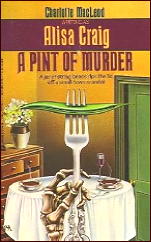
ALISA CRAIG – A Pint of Murder. Doubleday Crime Club, reprint hardcover, 1980. Detective Book Club, reprint hardcover, 3-in-1 edition. Bantam, paperback, 1981; Avon, paperback, 1988 (shown).
Of all the detective murder mysteries that have ever been committed in fiction, a small but sizable number of them have been tackled by a member of the Royal Canadian Mounted Police. Tackled and solved, of course. The Mounties always get their men, as everyone well knows.
Ms. Craig does nicely in adding to the total. The case is that of the food-poisoning death of a crotchety but scrupulously careful old lady in the New Brunswick town of Pitcherville. Inspector Madoc Rhys (a Welshman!) is the Mountie who is called in to investigate.
The story, well, it could be likened to a breath of fresh clear Canadian air, containing only the slightest bit of pollution, and that of the sort produced by the gossipy thoughts and attitudes of small village minds with nothing to rein them in.
This is also a book for those who do not mind a little romance mixing it up with their mystery fiction. By book’s end it quite definitely is clear that the Mounties almost always get their women as well.
Rating: C plus.
— Reprinted from The MYSTERY FANcier,
Vol. 4, No. 4, July-August 1980 (slightly revised).
Bibliographic Notes: This was the first of five books in the Alisa Craig’s Madoc Rhys series. Since I did not mention it at the time, I suspect that I did not know then what I know now: that Alisa Craig was a pen name of Charlotte MacLeod (1922-2005), who under her own name wrote both the Peter Shandy and the Sarah Kelling & Max Bittersohn series — among many other works of mostly humorous mystery fiction.
Wed 14 Aug 2013
Posted by Steve under
Reviews[5] Comments
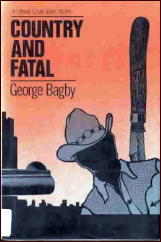
GEORGE BAGBY – Country and Fatal. Doubleday Crime Club, hardcover, 1980.
Need further proof that riding the Manhattan subway system can be dangerous to your health? On page one of Bagby’s latest mystery-adventure, you’ll find him being pushed off the Times Square station platform smack into the path of an oncoming train.
A series of such attacks has surprisingly nothing to do with Bagby’s friendship with Inspector Schmidt of Homicide, and the many cases they’ve worked on together. Rather it has everything to do with an ex-con country singer named Shad McGee (almost married to the phenomenally shelf-bosomed Lucinda Belle), who wants Bagby to give him a hand with his memoirs.
Names and any resemblances etc. etc. entirely coincidental. Not your usual background for a detective murder mystery, but it’s fun, and what’s more, the clues are fair. In fact, there’s one in particular that should have been obvious, and I missed it. I really don’t know what I was thinking of.
Rating: B minus
— Reprinted from The MYSTERY FANcier,
Vol. 4, No. 4, July-August 1980 (very slightly revised).
UPDATE [08-14-13]. George Bagby, pen name of Aaron Marc Stein, (1906-1985) was an extremely prolific mystery author who also wrote as Hampton Stone. I think I’ll repeat my update of my review of another of Bagby’s works of detective fiction, I Could Have Died, which you’ll find here:
“I don’t believe that George Bagby — in real life Aaron Marc Stein, under which name he wrote an equally long list of other detective novels — got nearly the critical attention that I always thought he should have, and he’s definitely forgotten by all but a few devoted aficionados now.
“Perhaps he was too prolific, and maybe the endings didn’t match the cleverness of other writers’ mysteries (nor perhaps the openings of his own books), but I always admired the way he had for descriptive passages, making the most prosaic actions — such as taking the cap off a toothpaste tube or hunting for a set of lost keys — seem interesting.
“George Bagby, by the way, if the review wasn’t quite clear on this, was both the pen name and the character in the Bagby novels who tagged along with Inspector Schmidt and chronicled his cases for him.”
I don’t remember who I was referring to in the first sentence of the third paragraph. It was 33 years ago when I wrote it, and while you may think everything you say or do will stay with you forever, it doesn’t. Thank goodness.
Fri 9 Aug 2013
Posted by Steve under
Reviews[5] Comments
MILES BURTON – The Man with the Tattooed Face. Doubleday Crime Club,US, hardcover, 1937. First published in the UK as Murder in Crown Passage, Collins, hardcover, 1937.
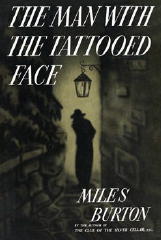
Immediately preceding the first page of The Man with the Tattooed Face you’ll find a map of the “downtown” section of the village of Faston Bishop, including all the salient details that describe the locale where the dead man is found, and believe me, it — the map, that is — gets a full workout.
The victim is — not too surprisingly — a man with a tattooed face. While he had earned his living as a common laborer on several of the farms surrounding Faston Bishop, he also seems to have been working very much below his true station in life. Rumors are also that he was not averse to carrying on an affair or two with some of the wives in the local area.
The detective on hand is Inspector Arnold of the C.I.D., and within the first 100 pages he has a theory that fits all the facts. Obviously it doesn’t, though — “obviously,” that is, if you’ve read as many mysteries as everyone else has who’s reading this review — and on page 173 is a timetable that leads soon to the discovery of the fatal flaw in his hypothesis.
Arnold’s good friend Desmond Merrion insists that the solution to the crime must come from the dead man’s unknown past. Arnold’s stubborn obstinacy to this plan of thought is quite inexplicable. And other than these two divergent approaches to the investi gation of the murder, the two amicable crime-solvers leave little to distinguish themselves, one from the other — or from countless other featureless detectives from the “Golden Age.
But the seductive lure and the leisurely pace of the classical mystery novel, told in simplest terms here as a puzzle in pure detection, these are what you’ll find in abundance, on every page.
Rating: B.
— Reprinted from
The MYSTERY FANcier,
Vol. 4, No. 4, July-August 1980 (slightly revised).
Fri 2 Aug 2013
Posted by Steve under
Reviews[2] Comments
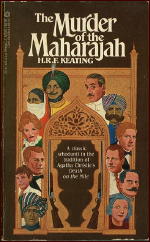
H. R. F. KEATING – The Murder of the Maharajah. Doubleday, hardcover, 1980. Pinnacle, paperback, 1983. First published in the UK: Collins Crime Club, hardcover, 1980.
If there were an award designed to be given every year to some new mystery in the memory of the late Agatha Christie — there isn’t, and why not? — this is the book that would make Keating this year’s hands-down winner. Not only does it owe a great deal to Mrs. Christie in time, the year 1930, and in exotic locale, India, when that land was still a formidable bulwark of the British Empire, but in atmosphere, characters (some of whom are actually seen reading a Christie novel) and leisurely pace as well.
The maharajah, never one to be crossed, is also inordinately fond of April Fool’s jokes, but one — a limousine’s plugged exhaust pipe — quickly comes home to roost (backfires?) when a plugged shotgun barrel is discovered to be the immediate cause of His Highness’s demise.
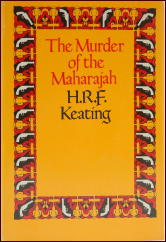
There are only a limited number of suspects, which should sound familiar, but even so D. S. P. Howard’s investigation into the case makes little initial headway, not even with the most highly enthusiastic help of the palace’s schoolmaster. Not until, that is, in grandly extravagant and artificial fashion — and comes the reminder that very seldom are mysteries written like this any more in today’s penny-pinching economies — an enormous royal banquet is recreated in the smallest detail, staged solely to help a murderer reveal himself.
Lots of red herrings, you can bet on that, a thwarted romance or two, and a clue I’m willing to wager a bevy of Imperial sandgrouse that you’ll never spot, no matter how earnestly and devoutly you try. And for those who have followed Keating’s long career in writing detective mysteries up to now, there is a last line that is utterly untoppable.
Rating: A minus.
— Reprinted from
The MYSTERY FANcier,
Vol. 4, No. 4, July-August 1980 (slightly revised). This review also appeared earlier in the
Hartford Courant.
















